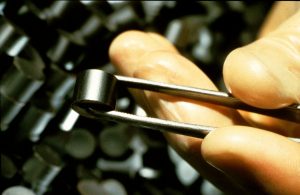Series of articles on barriers 2/6: The nuclear fuel matrix (fuel assemblies part 1 of 2)
The nuclear fuel is pressed into pellets and compacted using the sintering process before use in nuclear power plants. This process transforms the nuclear fuel into a ceramic material, which is able to retain the fission products that arise during operation in the nuclear fuel matrix.
The nuclear fuel is extracted from uranium ore, which is enriched in one of the additional manufacturing processes.
Enrichment of uranium
After uranium ore is mined, the uraniferous material is separated from the other rock. The uranium is chemically removed from the residual rock using acids or bases and is then purified. The product is a yellow powder, which consists of about 80 percent uranium compounds.
Natural uranium primarily consists of non-fissile uranium-238, while uranium-235 accounts for just around 0.7 percent. For a nuclear power plant reactor to function efficiently, the share of uranium-235 must be increased to about five percent.
Before enrichment, the yellow powder (also called “yellow cake” because of its colour) must be transformed into a suitable form. It is converted to uranium hexafluoride. This salt-like compound vaporises at 56°C. In its gaseous state, the uranium-235 and uranium-238 isotopes can, for example, be separated from each other by a rapidly rotating centrifuge, as uranium-238 contains three neutrons more and is therefore heavier than uranium-235.
Finally, the uranium-235 taken from one part is added to another part of the uranium. The enriched uranium is prepared for further use. The enriched uranium hexafluoride is subsequently converted back to uranium oxide.

Nuclear fuel is trapped in pellets
The enriched uranium oxide is ground, pressed into pellets and compacted by sintering at about 1,700 degrees Celsius, i.e. it is converted to ceramic material. This ceramic material is able to retain the fission products that arise during operation in the nuclear fuel matrix. The shape of these pellets is reminiscent of small black tablets; they are cylindrical and about one centimetre high and one centimetre wide. Pellets are only very weakly radioactive in their unused state; they only become highly radioactive in the reactor operation as a result of neutron bombardment and the resulting fission products.
The solid radioactive substances (and part of the radioactive noble gases) are trapped in a matrix in the pellets during the normal operation of the reactor. Together with the fuel rod cladding tubes, the nuclear fuel matrix is the first barrier for trapping radioactive substances.
This is the second of six articles on the topic of barriers for trapping radioactive substances. The first describes the barrier principle, while articles 2 to 6 describe the various barriers.

